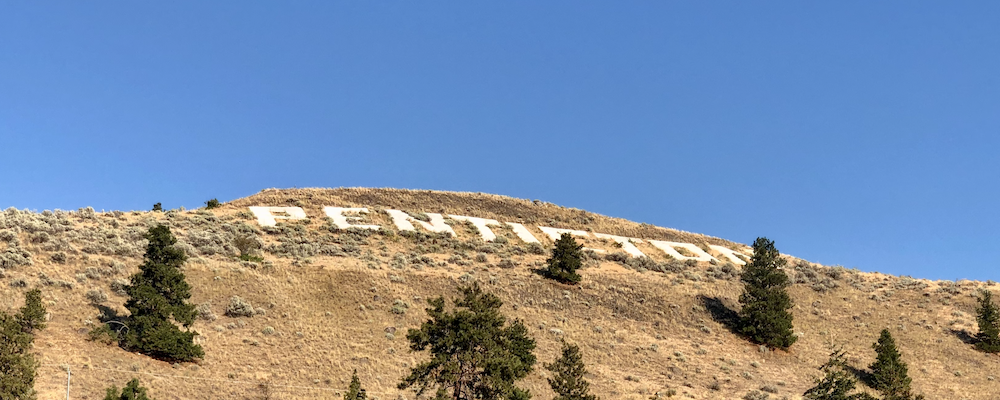Three years have passed since my very first Ironman race in Mont-Tremblant. Those Covid-years were full of uncertainties, cancelled events, closed swimming pools, running group limitations, and bike parts shortage. But finally, 2022 allowed for racing again, to an extent that I was wondering if I’d be in the right shape for competing in an Ironman again — by the end of July I had already done 3 marathons this year and not having been in the pool for 20 months. Would I be able to succeed in Penticton, where the legendary Ironman Canada returned to after two decades of absence? Here’s how I did.
[race report also available via Medium]

Travelling to Penticton
Packing a bike into a box and taking it in an airplane can be stressful when you’ve never done that before and especially in times when there is an airport staff shortage and tons of stories of lost luggage. It was a long journey from Ottawa, Ontario, to Penticton, British Columbia. I witnessed my bike box being thrown onto the conveyor belt, and other people’s bikes not even making it into the plane.
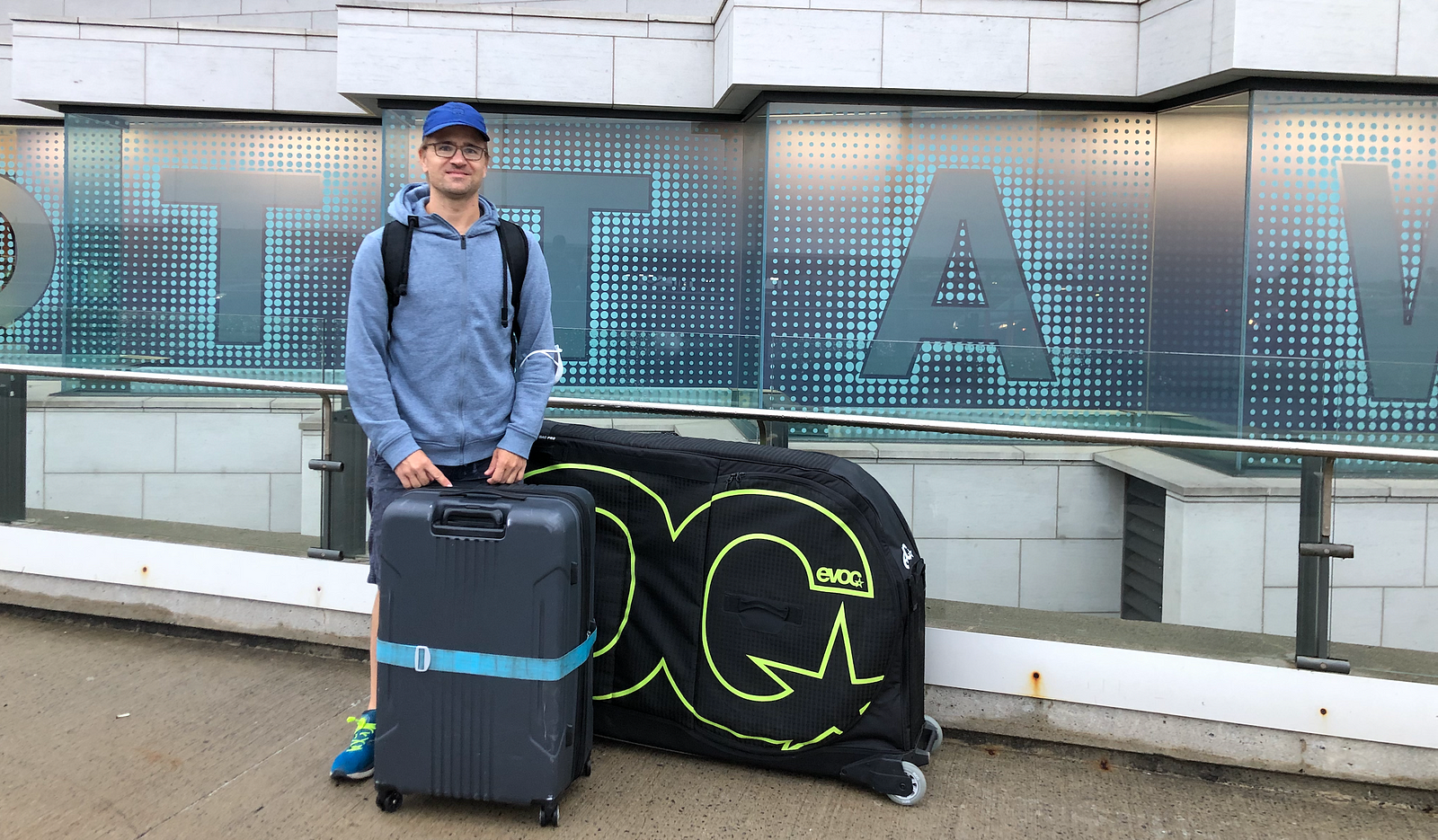
I made it, though, and so did my bicycle, with only very minor damage. At the airport I for some reason decided that it was a great idea to walk all the way to the hotel, pulling the bike box and a large suitcase for 6km through town, and after 1.5 exhausting hours I arrived on Lakeshore Drive in Penticton, where my hotel was located just a short walk from where the race would start five days later.
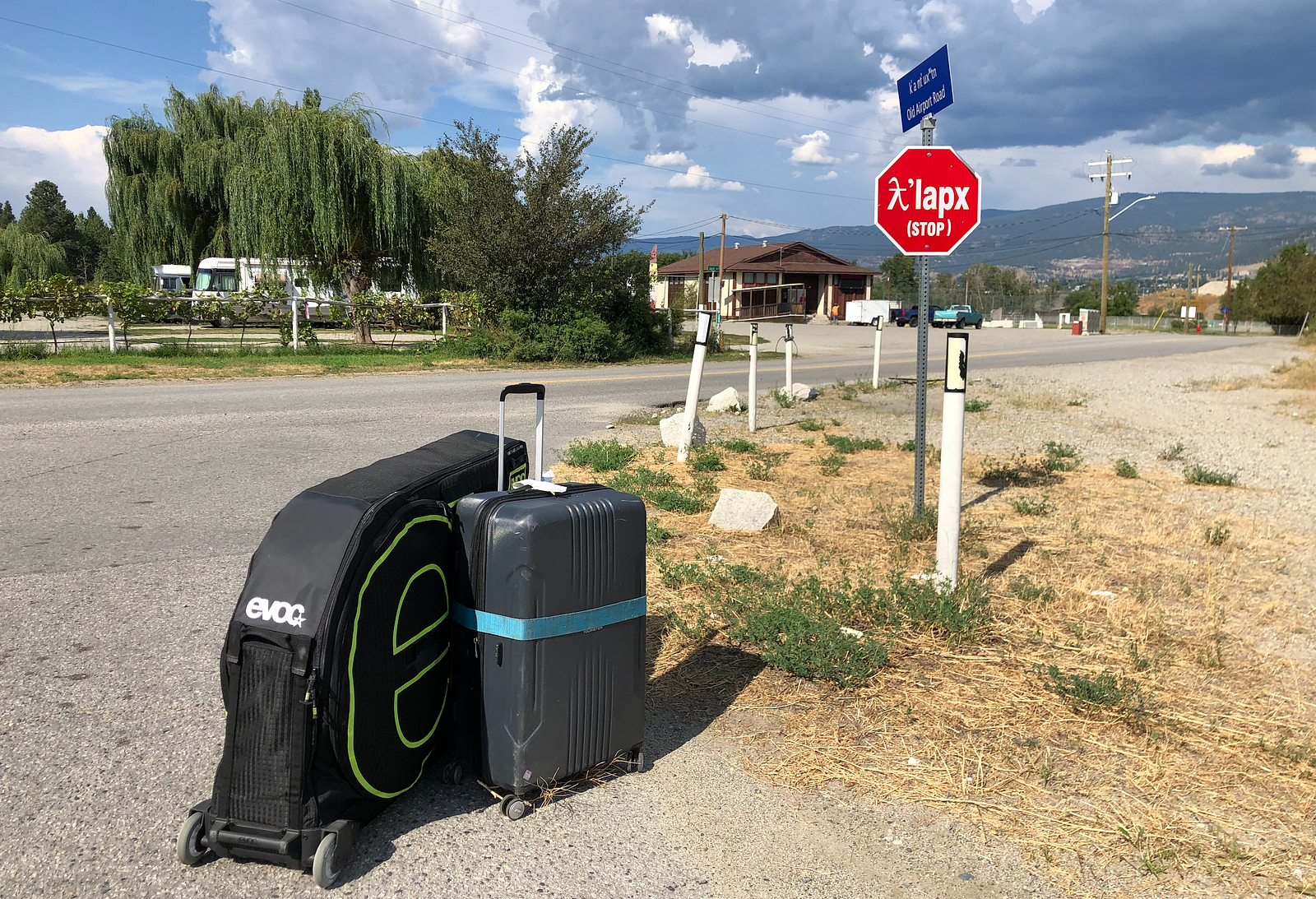
Arriving well in advance of an Ironman event is just perfect. Any potential damage or missing items can still be taken care of without stress. You have enough time to familiarize with the venue and the surroundings. You can put in some training right on the race course. You experience the race atmosphere building up and get to know the community.
Time passed by quite quickly, though, and suddenly race day was here: August 28, 2022.
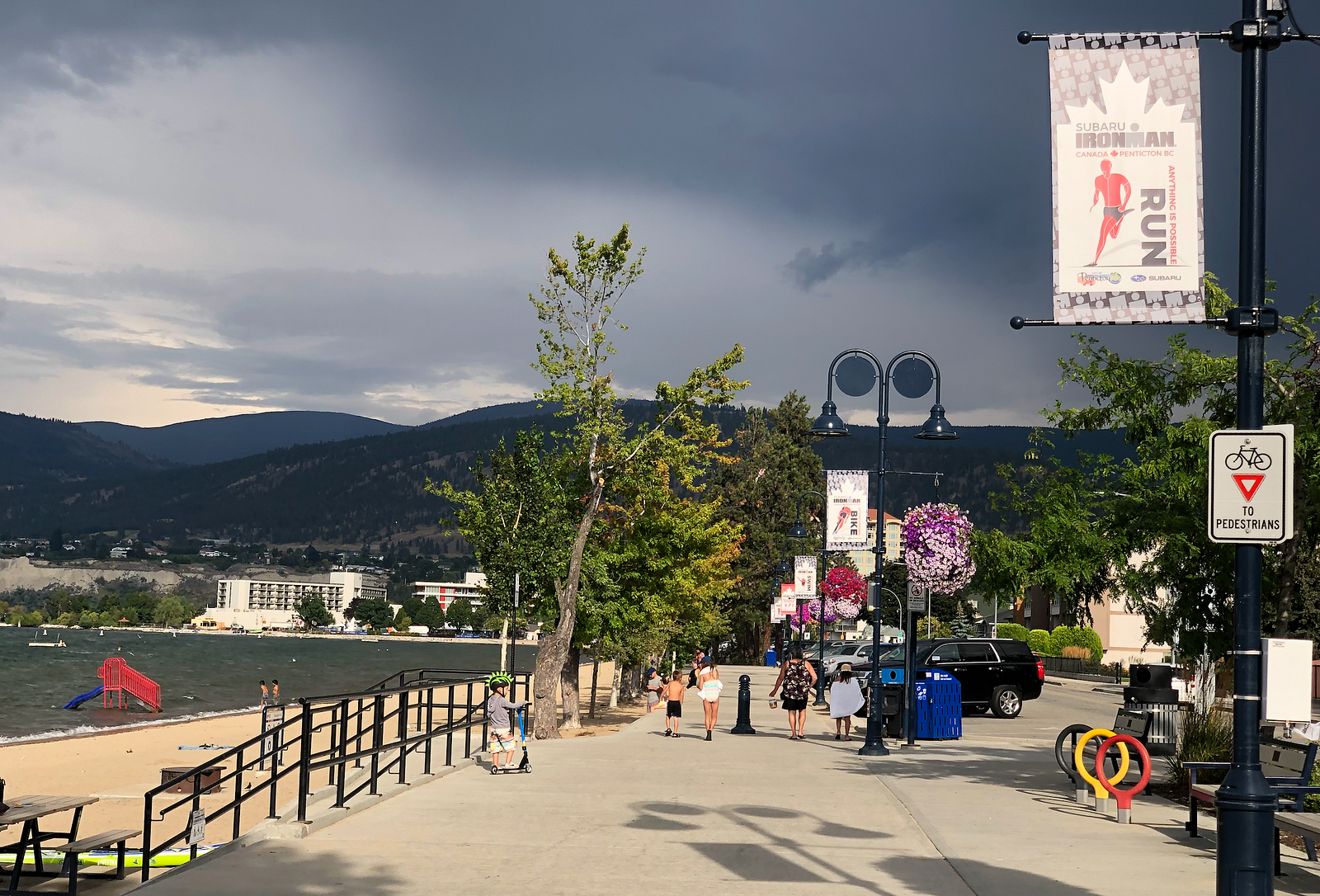
Swim: 3.8 kilometres
I’ve never been a great swimmer and in fact I only learned to properly front-crawl not all too long ago. I still remember myself not being able to even swim ten meters without having to stop and grasp for air. Over the years I became somewhat used to it, put in the training, and learned to endure in the water — and yet, the aquatic part of triathlon is not my favorite; whenever I could I found excuses to not go to the pool. I managed to not swim at all for almost two years and now was to be competing in a pretty long event. Only four weeks ago I picked up pool training again, and only did two open-water swim sessions before traveling to Penticton. I felt unprepared. I was nervous.

Okanagan Lake turned out to be a beautiful body of water. A huge lake, surrounded by impressive mountain formations and picturesque wineries and a long walkable beach on its southern shore, the heart of Penticton. My hotel was just steps from that beach, so I was able to test the waters during the days before the race, gaining some confidence. That confidence only lasted until the third day, when the lake got so choppy it looked more like an ocean trying to scare swimmers away. I never swam in such waves before! This twenty minutes training swim felt horrible, yet I was happy to experience the lake’s more violent side.

Getting up early
On race day, my alarm was set to 3:30am, allowing myself three hours before the event would start. I stepped out of my room in the dark to find a clear sky, no wind, and no waves! What a relieve. I slowly drank my coffee, ate two English muffins for breakfast, and calmly got ready: collecting all the nutrition from the fridge and freezer (cheese sandwiches, Clif bars, Xact bars, water bottles, and my frozen hydration pack full of a mixed Tailwind drink); debating which tri-suit to wear and deciding to go for the brand new one I just bought two days ago; double-checking my morning gear (wetsuit, swim goggles, swim cap, sweatpants, slippers, etc.). Shortly after 5am I’d meet Josué to walk that one kilometre to the transition, where I had already prepared my bike the day before.
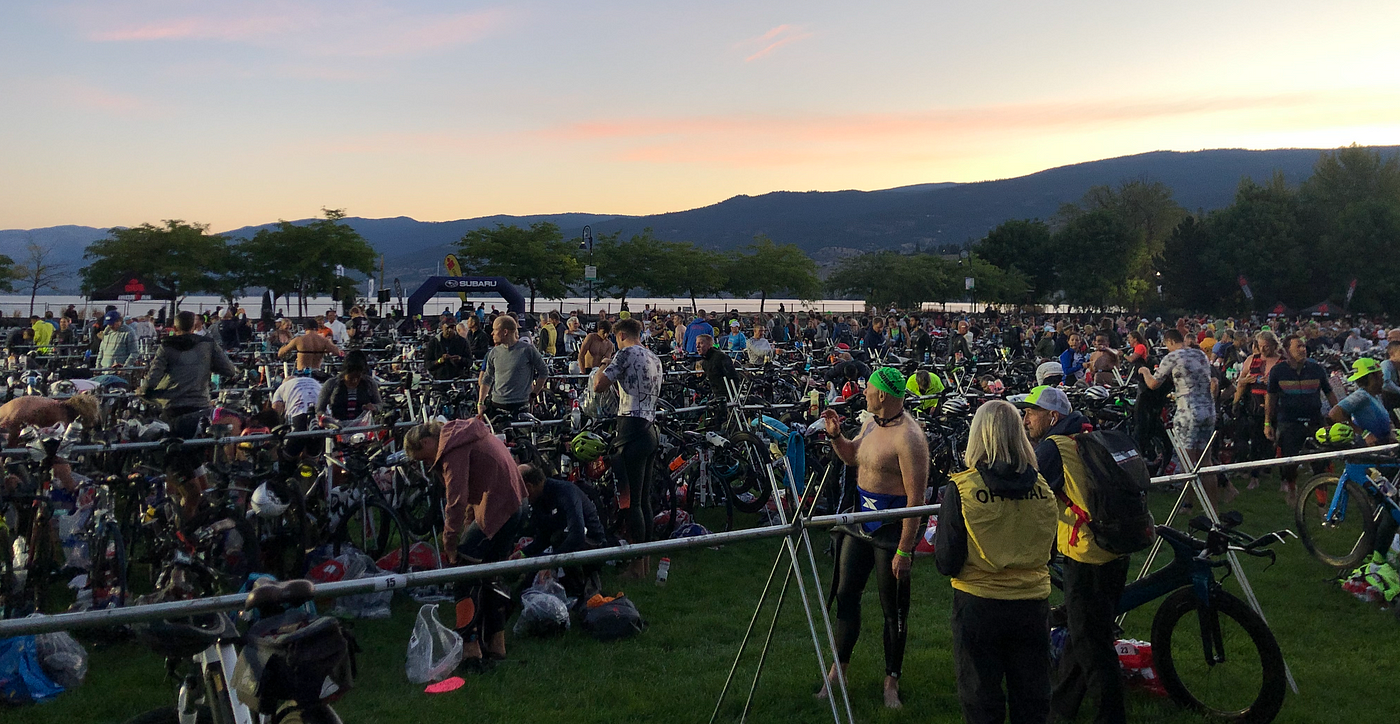
Time passed by quickly that morning. While the sun was coming out, I checked my bike and tire pressure one last time, set up transition zone, put on the wetsuit. And by 6:15 I was ready to go — in between 1500 other athletes, waiting to be released into the water!
Into the water
All the pre-race anxiety is completely gone once you start swimming. The only focus now is on each single stroke you do, each single breath you take, and on the next yellow buoy to pass. The swim course itself was quite easy: one loop, in clockwise directions, just following the yellow buoys (one every 100 meters or so), and once you hit a red one, you have to do a slight turn. For the first part of the loop I’d have the sun in my back; which helped massively in sighting and spotting landmarks. I kept calm, didn’t put too much effort into the swim. The swimmers around me helped to get a sense of direction, and once in a while I found someone to draft off, giving me some extra speed. Despite the fact that I don’t consider myself a great swimmer, and that I only started swim training again a couple weeks back, I felt very comfortable. Even having other athletes right next to me, or swimming over my legs, or crossing right under my face and chest didn’t make me panic. One thought kept crossing my mind, and I remember having the same thought during my first competition in Mont-Tremblant three years ago: “I’m doing it, I am in the midst of a long-distance triathlon, and today I’ll become an Ironman again!”

One stroke after another, one buoy at a time. Every 500m my Garmin watch would vibrate, haptically indicating the distance. I knew it was going to be a long swim, but somehow time passed quickly. At some point, sighting became more difficult (foggy googles, and swimming back towards the sun), but there were enough other swimmers around me and enough volunteers on kayaks that I didn’t waste too much energy swimming in wrong directions.
After one hour and eighteen minutes I left the water, finding my way back into the transition area. So happy to finish the swim without any issues, or chafing, or cramps!
Cycle: 180 kilometres
The advantage of being an average swimmer is that you usually have some space around your bike in transition. The fast ones are already out cycling. When I got to my bike I got out of my wetsuit (which usually takes a while), and tried to get my thoughts straight, to not forget anything; I’d be out on the road for the next six hours! Hydration; eat a Clif bar and don’t just swallow it like you did the last time; put on helmet and shades; dry your feet, put on socks and bike shoes; clip the Garmin head unit onto bike and turn it on; generously get this chamois cream between your legs; apply sunscreen on calves, arms, neck, and face; put on cycling gloves. And then grab your bike and run out of transition.

A little less than nine minutes after exiting the water I hopped onto my bike. Although the sun was out and it promised to be a great day for a ride, my dripping wet tri-suit made me feel quite cold during those first kilometres.
A gentle beginning
The beginning of the course was quite flat, even with a slight downhill, right east along Main Street in Penticton. Just two days ago I’d ridden that section in training and new what the first half hour on the course would be like: fast, good asphalt, and once we were out of the city, very scenic along a lake. I felt great and full of enthusiasm for the upcoming ride. It didn’t take too long until I found a good pace, tucked myself into aero-position and pedalled at a constant wattage of around 3.0–3.3 watts per kilogram, and close to 40km/h.

It took me around 25 minutes until the first hill provide a bit of a taste of what else was about to come. For approximately five kilometers we had to climb some pretty steep sections up McClean Creek Road. I love climbing hills, and my comparably light road bike helped me to pass quite a number of athletes on the incline. I had no idea though, what else would be coming… not yet though, since after an amazing downhill the course just couldn’t get much better: for almost 40 kilometers we were all basically flying down a net downhill with only occasional easy inclines, even enjoying a slight tailwind. By the end of the first third of the course I averaged around 37km/h without pushing all too hard. The course profile, as well as the weather, really played into my nutrition strategy. I ate another Clif bar, as well as the one of the cheese sandwiches that I taped to my bike’s top tube (the second sandwich mysteriously disappeared within the first 10 minutes). Eating while riding is not great, and I certainly wasn’t hungry at all, but I knew that I couldn’t only rely on those 1000 calories of sugar-water in my water bottle, but had to have some solid food as well; and consuming bread and bars would only get harder throughout the race.
Every 20 kilometers I passed a water station, at which I exchanged an empty for a full water bottle. The volunteers were amazing, and it wasn’t problematic at all to grab some water while passing by. At no point did I feel unsafe. I took full advantage of all the stations, which means that I drank more than 750ml every 40 minutes!
The climbing begins
The easy part of the course would end abruptly when we all turned around in the town of Osoyoos, where the climbing would begin. I wasn’t too familiar with the course (on purpose!), but I heard people say that this would be the road to Richter Pass, a 12km long, steady incline on Highway 3. Ok, I thought, this is that Richter Pass everyone is talking about, so lets get this over with and enjoy the downhill to come. Little did I know that this was the easiest of the climbs to come…

As mentioned before, I love climbing with the bike. My 52/32 gear ratio allows me to keep a reasonably high cadence at a good wattage, and I must have passed dozens and dozens of cyclist on that first long hill. 12km sounds terrible, but I did enjoy it — above all, I enjoyed the views! It didn’t take long and you could look down onto Osoyoos Lake, which was surrounded by tree-spotted South Okanagan mountains, vineyards, and farmland. Blue skies and some scattered fluffy clouds created some ridiculously picturesque images that really made you forget the occasional pain in your legs. 38 minutes later I reached the top and was awarded with not only a good crows of cheering volunteers and spectators, but also with the first real downhill section, reaching speeds above 70km/h!
Rolling hills?
What came next is officially called ‘rolling hills’, but can’t be better described as the following:
“This is the home of the infamous ‘7 Bitches’. The first climb is around 2km at a 3% to 4% grade, taking you through some stunning scenery and dropping you just past Nighthawk Road. From here it is another wild descent to a series of rollers that skirt the Similkameem River. […] The rollers are another fabled aspect of the Penticton Bike Course. The truth is that these tend to be mental rather physical protagonists. The fast descents highlight how slow the climbs are. The ups are long enough to play tricks on your mind. The downs fast enough to go by in the blink of an eye. What you are left with is a lot of time climbing and not much time descending. Those who are mentally fragile will struggle, this is the playground of the endurance bunny.
These are not rollers in the true sense of the word. You don’t get to speed down and momentum your way back up. Well, you do, but only a little. These are climbers, more than rollers. Speed sapping ‘rollers’ that have an adverse effect on your bike computer — somehow making the distance digits tick by slowly and the timer speed up. Sorcery!”
(Penticton bike course summary at pbandjcoaching.com)
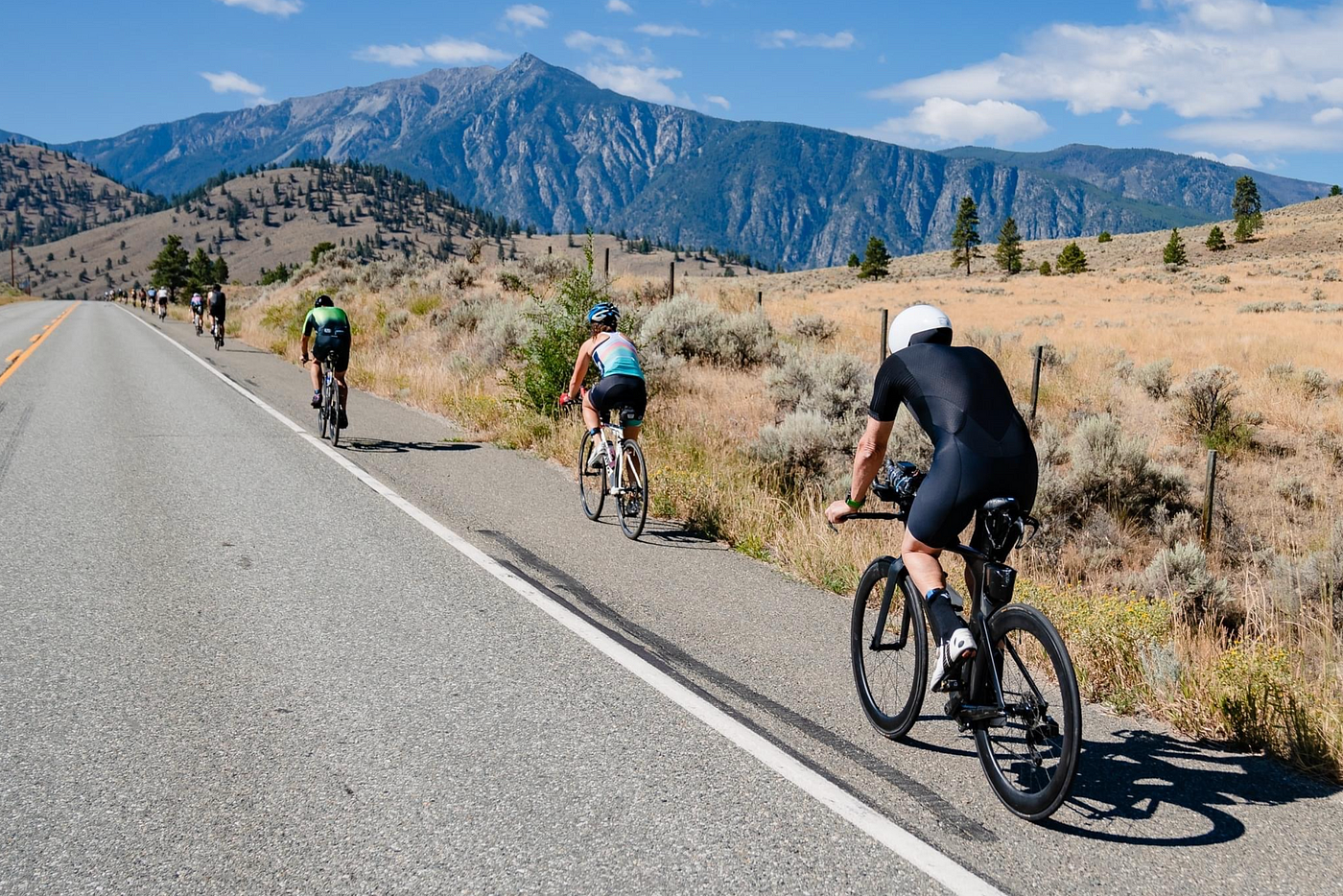
Mood down
It was around the 120km mark when I experienced a mental low point. In the middle of an even longer climb up to Yellow Lake. I’d been riding my bike for 3.5 hours now, and there was still enough distance for at least two additional hours left. My neck hurt, my saddle felt more and more uncomfortable, I had pain in my shoulders. All I wanted is to finish that ride, end this suffering. This is when experience really helps. I had done an Ironman before, and only a couple months ago I’d participated in an ultra-cycling event, covering 450km in 36 hours. I had learned that no matter how shitty you feel at one point, you may start feeling better at a later one. As long as you keep pushing through, as long as you withstand the urge to stop. Acknowledge the pain, memorize it, but don’t let it become your center of attention. Instead, I focused on how well I’d actually been doing so far! Still averaging well above 30km/h overall, I realized that I may be able to finish that challenging bike course in under six hours; faster than I had hoped for! So I kept going. Pedal stroke after pedal stroke, up that street to Yellow Lake.
Mood up
Knowing that a long descent would follow, my mood slowly started getting better. Each kilometer would bring me closer to Penticton, and once my Garmin kept counting closer to 150km, I knew that it was only one more hour to go.
If only the course planners wouldn’t have had that sadistic idea to build in a 10km out and back section that starts with a 150m vertical decline… how demoralizing it felt to descent further and further, while seeing all those faster cyclist climbing up the same hill that you’d have to climb up yourself later, too… and those climbs would be by far the hardest ones on the course; with up to 15% incline, many athletes decided to walk their bikes. Not me, I thought to myself, I’m gonna push one last time and grind up those walls.
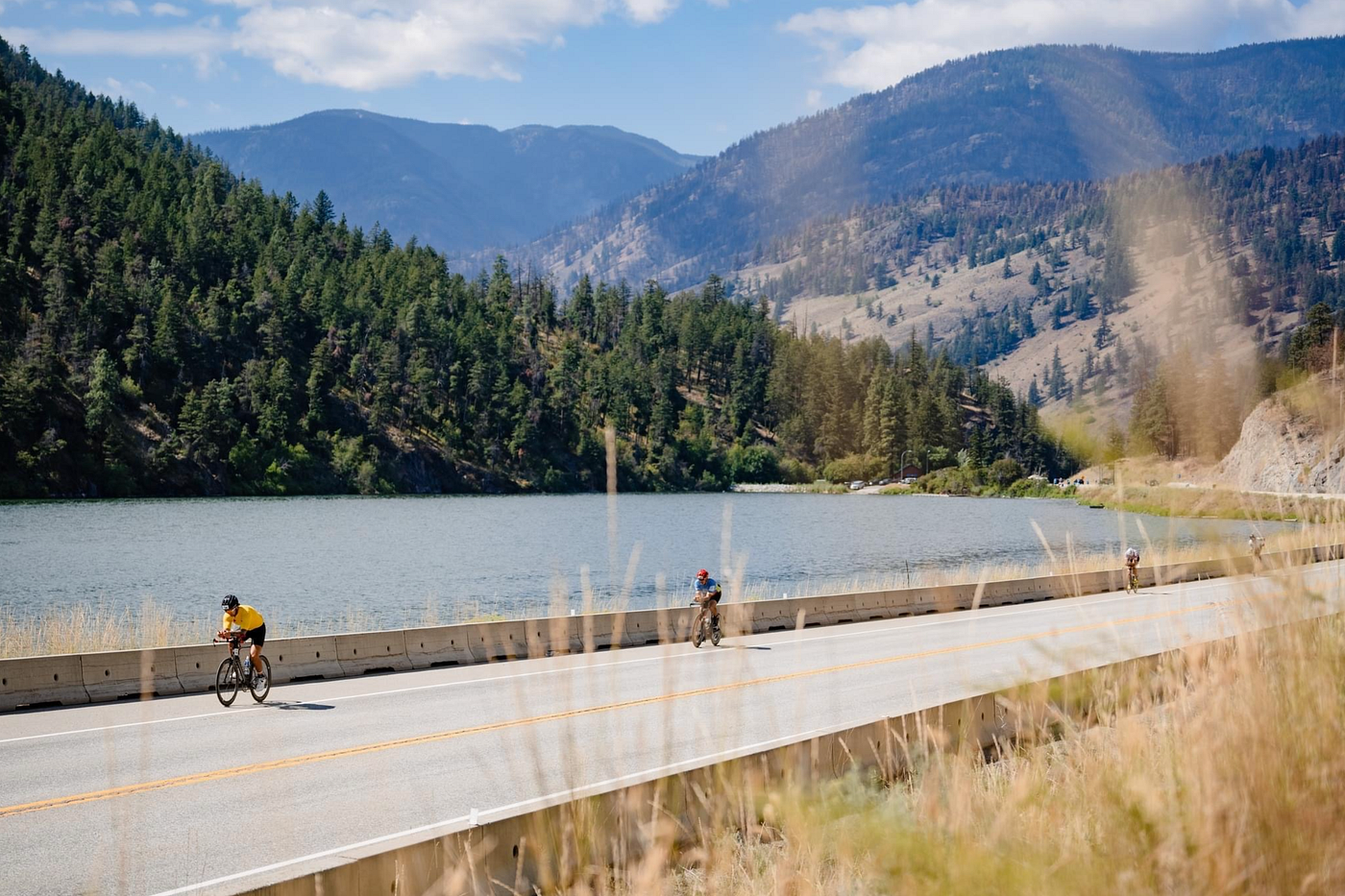
Once I finished that section, my mood was on a high again. I knew that Penticton was close, I could already see it from above. A 15km net downhill followed and flying back into town was just so much fun — I felt so sorry for those cyclist that got flat tires at this point in the race and just hoped to not have the same bad luck. I pushed some more watts, passed some more bicycles, and made it through an unnecessarily exhausting headwind section on Main Street back to the transition zone. The 180km bike leg was done in well under six hours!
Run: 42.2 kilometres
Getting off the bike was a relieve. As much as I love cycling, spending such a long time in the saddle apparently is exhausting. And while on a normal day, a hot shower and my couch would be calling at this point, on Ironman day, there was still a full marathon to be run. What a dazzling thought. But other than three years ago today I knew that it is possible — even if my legs did not agree at all.
Changing from your bike to your run outfit is much easier than transitioning from swim to bike: just take off your helmet, switch shoes, and put on the race belt with your bib number. Oh, and in my case, don’t forget your hydration backpack.

What a mishap!
I am used to running with a silicone bladder full of water on my back. This gives me some piece of mind, and independence of on-course nutrition stations. To hydrate during a marathon run I’d mix 2 liters of water with 10 scoops (1000 calories) of tailwind, which usually is enough to power me through those 42 kilometers. In order to be able to enjoy that super-sweet mixture, I like it to be as cold as possible; which is why I put it in the freezer the night before race day. Great idea in theory, bad idea in practice: when I came back to transition almost eight hours after the start my entire water supply was still solidly frozen! Hoping that it would thaw along the way, I buckled the hydration backpack and found my way to the run exit.
From the very start of the run, I felt like I usually do during the last part of a marathon: super tired legs, stiff hips, high heart rate, and out of breath. The run course started with a brutal uphill section, that led the athletes from downtown up into the vineyards. Without any second thought I walked that hill, and so did most of the runners around me. This was going to be a very long day. And a bit of an unknown territory, since I hadn’t done any substantial brick training sessions in the past two years, no long run following a long ride since 2019.

After the first hard climb we ran on a gravel road with the most beautiful views onto Okanagan Lake and the surrounding mountains. Visually the best part of the whole run course!
Change of strategy
Seeing all these other athletes struggling with the sun, and the rolling hills, somehow gave me confidence. My pace was okay (around 5:30min/km) but I decided that I would walk every water station, getting as much fluids as I could possibly digest. Without my original nutrition plan I needed to rely on the calories at those nutrition stations, which were basically limited to Gatorade, Coke, Red Bull — the gels and bananas weren’t an option since my body doesn’t take anything other than fluids on a run.
That new race strategy seemed to work well at first: every 2km I passed a water station, slowed down, grabbed water, ice, Coke, Gatorade, and drank 3–4 of those small paper cups. I occasionally put ice into my cap, to cool down my head and neck. Always hoping that 2-kilogram ice block on my back would eventually melt, releasing additional calories.
False hopes, as I learned along the way. While at some point the block thawed, the Tailwind powder had separated from the water and clocked the tube through which I would have sucked in the drink. I kept trying, but no fluids at all would make it through the hose. Which became a bigger and bigger problem: the calorie density of Gatorade or Coke is much smaller than what I had prepared in my hydration bladder, so I needed to take in way more fluids than I could; resulting in stomach aches and making this whole run feel even harder.

The challenge gets harder
After 10km into the run, the course was back in town, and we’d now had to complete two 15km loops basically out and back on Main Street, and along Lakeshore Drive. That Main Street section was not enjoyable — basically 5km just straight, turn, and 5km back. Spectators and volunteers made this section somewhat bearable but running through what felt to be an industrial park (with fast food chains and car dealerships on both sides of the road) is not what you need when your mentally at a low point. I kept walking the water stations, and used the opportunity to talk to other folks, having their own hard time.
Every kilometre felt longer than the previous one. But I kept going. I knew that I’d have more than enough time to finish before the cut-off at midnight, and I knew that the biggest part of the race was already done. And despite the pain, despite the comfort, despite that never ending Main Street, I did enjoy my surroundings. Thanking the volunteers, getting cheered on by the spectators, and having chats with fellow athletes is just the best part of it all.
Calculated hope
It was around kilometre 30 when I looked at my current overall time on my Garmin, realizing that I still could finish the race in under 12 hours if I only kept a pace of 6 minutes per kilometre or less. Earlier during the run I was sure that I wouldn’t be able to beat my finishing time from three years ago but suddenly it seemed possible. 12 more kilometres of pushing, less walking breaks, and steady running — having a sub12 hours finish time in sight gave me quite a motivational uplift! As much as everything hurt, I know it was going to be a strong finish!
How happy I was when I completed Main Street one last time. I picked up my pace to around 5:20min/km, and the closer I got to that finish line, the faster I seemed to be getting. The water stations still made me walk to continue hydration and calorie intake, but in between them my legs wouldn’t slow down anymore. The atmosphere along Lakeshore Drive was exciting and on those final two kilometers one could hear the finish line announcements already. More and more spectators along road were looking for their athletes, cheering on everyone who’d run by. One more kilometre. I picked up the pace once again, feeling completely pumped. The last 200 meters it felt like sprinting, going well below 4:15m/km, and, finally, crossing that finish line: “You are an Ironman!”
An Ironman who just carried 2kg of water on his back for 42 kilometres.

Recovery!
Complete exhaustion. The medal, the hat, and the shirt they hand over right after the finish line were less attractive in that moment than the next chair to sit down on. Feelings of weakness and nausea overcame me, signalling that this final sprint was all that was left in me. Instead of food I decided to check out the medical tent, just in case. I felt cold, and the idea of lying down for a minute, and getting served some hot chicken broth was just too intriguing. While taking in some nutrients and electrolytes my mind started realizing I did this again! I raced a total of 226 kilometres and climbed more than 2000 vertical meters in 11 hours and 54 minutes, 12 minutes faster than three years ago. All on so much less structured (and almost no swim) training than back in 2019, and after an already very busy season including three full marathons within the months leading up to Ironman.

The rest of the evening was spent in the spirit of Ironman — cheering on those brave and unbelievably strong athletes that were still out there on the course! The later it got, the better the atmosphere. Sun had set long ago, but the party just got started. Each runner was welcomed with such excitement, being enthusiastically called an Ironman when crossing that finish line. This is what makes these events what they are; the last finishers are celebrated the most. By fellow athletes, spectators, volunteers, medical staff, and everyone else who happened to be around.
What’s next?
Earlier this training season I was almost sure to retire from long-distance triathlon. Mainly because of the swim part (did I mention that swimming is not my favorite?) and because I wanted to focus on ultra-trail running more. After Ironman Canada though, I got hooked again. Hooked by that finish line atmosphere, hooked by the mysterious magic around Ironman — even though the corporation itself seems to be drifting more and more away from being athlete-centred; they still put on a great show.
Not even within a week post-race I decided to continue this journey in 2023: one Half-Ironman (IM 70.3 Musselman, early July), one full Ironman (IM Lake Placid, late July), and possible another full Ironman later that year.
What’s left for 2022: Fall Colors Half Marathon in Cumberland/ON; Relentless Ark 50k Ultra-Trail in Low/QC; Hamilton Marathon.

Stats
All the stats related to Ironman Canada 2022, some of which are compared to my first long-distance triathlon (Ironman Mont-Tremblant 2019):
Individual times for each discipline:
Swimming 3.8km: 1h19min (+5min) | Transition 1: 8min (-6min) | Cycling 180km: 5h51min (-16min) | Transition 2: 10min (-1min) | Running 42.2km: 4h25min (+5min) | Total time for 226km: 11h54min (-12min)
Nutrition consumption on race day:
Fluids: 10.6 litres (-600ml) | Burned calories: 6800 (-700) | Consumed calories: 4400 (-1200) | Carbs: 730g (-470g)
| IMC 2022 | IMMT 2019 | |
| Weekly training time | 9h | 11h |
| Total training distance | 5913km | 6295km |
| Total training time | 313h | 388h |
| Swimming distance | 21km | 135km |
| Cycling distance | 3900km | 5145km |
| Running distance | 1990km | 1160km |
| Cycling more than 100km | 3x | 5x |
| Longest ride | 226km | 137km |
| Running more than 30km | 8x | 5x |
| Longest run | 42km | 42km |
Aftermath
In each race you gain more experience; each race is not only an opportunity to have fun, but to learn, too. That’s from the latest one:
- Don’t freeze your main hydration supply the night prior to race day. It may not thaw in time. And if you end up with a block of ice on your back: think about pouring it out sometime during the run.
- Tailwind powder separates from water when thawing. Avoid freezing Tailwind drinks.
- Familiarize yourself better with the course. Those hills were surprisingly steep and long, I was not mentally prepared for that. Luckily, I love riding up hills.
Comparing IM Canada to IM Mont-Tremblant
After having done two Ironman races it is time to compare. Mont-Tremblant (IMMT) has an almost perfect reputation, but so had Penticton (IMC). There’s three years and one pandemic between those two races and naturally things may have changed; but anyways, here’s my views:
- The volunteers make sports events what they are. At both locations the volunteer squad was just incredibly amazing. Present, helpful, friendly, enthusiastic. They all knew what they were doing, were extremely approachable, supportive, and patient.
IMC 1:1 IMMT - What you get for what you pay: IMMT had more to offer. The spaghetti diner along all the athletes in Mont-Tremblant was just more fun than spending a $25 food voucher in Penticton. We also got warm food at the finish line in Tremblant, with different choices, while in Penticton we were only offered pre-packed wraps. This may all be due to Covid measurements, but at least some hot soup or poutine would have been appropriate. Also, the transition zone in Tremblant was more organized and lastly, Mike Reilly announcing at the finish line just cant be beaten.
IMC 1:2 IMMT - Swim course: Both locations offered a one loop swim in a clear and calm lake, and both were wetsuit legal on race day.
IMC 2:3 IMMT - Bike course: The overall elevation was similar in both locations, but Penticton’s hills were much steeper — that course seemed more challenging to me. While Penticton’s views are much more scenic then Tremblant, I found the road conditions a bit rougher. Also, traffic control seemed safer in Tremblant. Penticton offered one loop vs. two loops in Tremblant. While the former may be nicer for the athletes, the latter may be preferred by spectators. Overall, that’s a tie.
IMC 3:4 IMMT - Run course: That one’s clearly a point for Mont-Tremblant. While the first 10km in Penticton were quite scenic, those final two laps on Main Street were not my thing. Tremblant’s run course also had much more protection from the sun, and the loop around the village was pretty neat.
IMC 3:5 IMMT
If anyone asks me which event to do first: I’d opt for Mont-Tremblant.
Let me know in the comments if you made different experiences!


